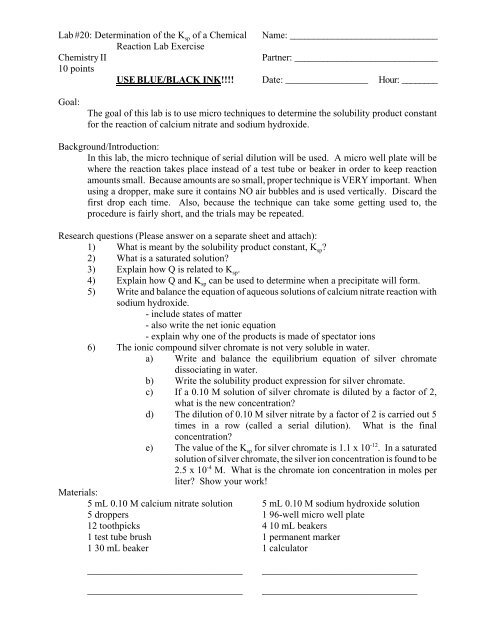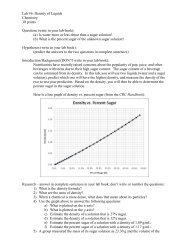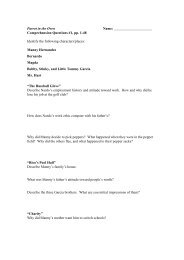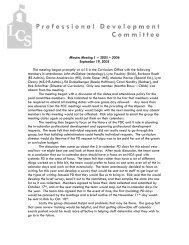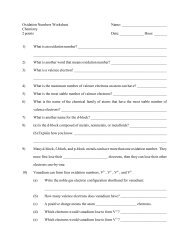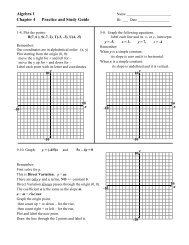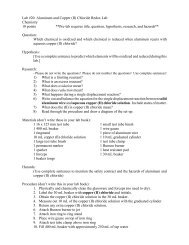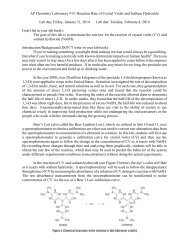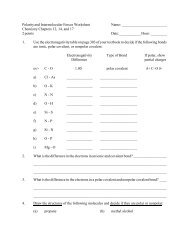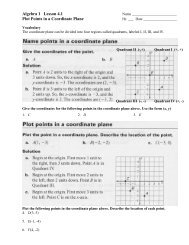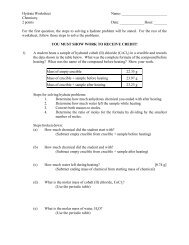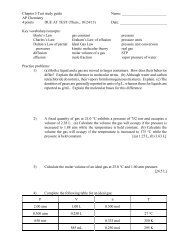Lab #20: Determination of the Ksp of a Chemical Name: Reaction ...
Lab #20: Determination of the Ksp of a Chemical Name: Reaction ...
Lab #20: Determination of the Ksp of a Chemical Name: Reaction ...
Create successful ePaper yourself
Turn your PDF publications into a flip-book with our unique Google optimized e-Paper software.
<strong>Lab</strong> <strong>#20</strong>: <strong>Determination</strong> <strong>of</strong> <strong>the</strong> K sp <strong>of</strong> a <strong>Chemical</strong> <strong>Name</strong>: _______________________________<strong>Reaction</strong> <strong>Lab</strong> ExerciseChemistry IIPartner: ______________________________10 pointsUSE BLUE/BLACK INK!!!! Date: _________________ Hour: ________Goal:The goal <strong>of</strong> this lab is to use micro techniques to determine <strong>the</strong> solubility product constantfor <strong>the</strong> reaction <strong>of</strong> calcium nitrate and sodium hydroxide.Background/Introduction:In this lab, <strong>the</strong> micro technique <strong>of</strong> serial dilution will be used. A micro well plate will bewhere <strong>the</strong> reaction takes place instead <strong>of</strong> a test tube or beaker in order to keep reactionamounts small. Because amounts are so small, proper technique is VERY important. Whenusing a dropper, make sure it contains NO air bubbles and is used vertically. Discard <strong>the</strong>first drop each time. Also, because <strong>the</strong> technique can take some getting used to, <strong>the</strong>procedure is fairly short, and <strong>the</strong> trials may be repeated.Research questions (Please answer on a separate sheet and attach):1) What is meant by <strong>the</strong> solubility product constant, K sp ?2) What is a saturated solution?3) Explain how Q is related to K sp .4) Explain how Q and K sp can be used to determine when a precipitate will form.5) Write and balance <strong>the</strong> equation <strong>of</strong> aqueous solutions <strong>of</strong> calcium nitrate reaction withsodium hydroxide.- include states <strong>of</strong> matter- also write <strong>the</strong> net ionic equation- explain why one <strong>of</strong> <strong>the</strong> products is made <strong>of</strong> spectator ions6) The ionic compound silver chromate is not very soluble in water.a) Write and balance <strong>the</strong> equilibrium equation <strong>of</strong> silver chromatedissociating in water.b) Write <strong>the</strong> solubility product expression for silver chromate.c) If a 0.10 M solution <strong>of</strong> silver chromate is diluted by a factor <strong>of</strong> 2,what is <strong>the</strong> new concentration?d) The dilution <strong>of</strong> 0.10 M silver nitrate by a factor <strong>of</strong> 2 is carried out 5times in a row (called a serial dilution). What is <strong>the</strong> finalconcentration?e) The value <strong>of</strong> <strong>the</strong> K sp for silver chromate is 1.1 x 10 -12 . In a saturatedsolution <strong>of</strong> silver chromate, <strong>the</strong> silver ion concentration is found to be2.5 x 10 -4 M. What is <strong>the</strong> chromate ion concentration in moles perliter? Show your work!Materials:5 mL 0.10 M calcium nitrate solution 5 mL 0.10 M sodium hydroxide solution5 droppers 1 96-well micro well plate12 toothpicks 4 10 mL beakers1 test tube brush 1 permanent marker1 30 mL beaker 1 calculator________________________________________________________________________________________________________________________________
Hazards:____________________________________________________________________________________________________________________________________________________________________________________________________________________________________________________________________________________________________________________________________________________________________________________________________________________________________________________________Procedure:1) Physically and chemically clean, dry, and label <strong>the</strong> beakers.a) label one 10 mL beaker 0.10 M calcium nitrateb) label ano<strong>the</strong>r 10 mL beaker 0.10 M sodium hydroxidec) label <strong>the</strong> third 10 mL beaker distilled water for dilutingd) label <strong>the</strong> fourth 10 mL beaker distilled water for rinsinge) label <strong>the</strong> 30 mL beaker waste2) Obtain <strong>the</strong> solutions in <strong>the</strong> 10 mL beakers.3) Arrange <strong>the</strong> micro well plate so that <strong>the</strong>re are 12 wells across from left to right.4) Perform a serial dilution <strong>of</strong> calcium nitratea) Put 5 drops <strong>of</strong> 0.10 M calcium nitrate solution in well #1 in <strong>the</strong> firstrow. NOTE: Hold <strong>the</strong> dropper vertically when dispensing <strong>the</strong> drops!Make sure no air bubbles are in <strong>the</strong> end <strong>of</strong> <strong>the</strong> dropper. Discard <strong>the</strong>first drop into <strong>the</strong> 30 mL waste beaker, as it may contain an airbubble.b) Place 5 drops <strong>of</strong> distilled water in each <strong>of</strong> <strong>the</strong> wells #2 through #12in <strong>the</strong> first row.c) Add 5 drops <strong>of</strong> 0.10 M calcium nitrate to well #2.d) Use an empty dropper to mix <strong>the</strong> solution in well #2 thoroughly bydrawing <strong>the</strong> solution into <strong>the</strong> dropper and squirting it back severaltimes. NOTE: The solution in well #2 is now 0.050 M Ca 2+ ions.e) Use <strong>the</strong> dropper to remove solution from well #2 and add 5 dropsfrom well #2 into well #3.f) Put <strong>the</strong> remaining solution back into well #2.g) Rinse <strong>the</strong> dropper by drawing some distilled water for rinsing up andsquirting it into <strong>the</strong> sink several times.h) Repeat 4d to mix <strong>the</strong> solution in well #3.i) Continue <strong>the</strong> serial dilution process, adding 5 drops <strong>of</strong> <strong>the</strong> previoussolution to <strong>the</strong> 5 drops <strong>of</strong> distilled water in each well down <strong>the</strong> rowall <strong>the</strong> way through well #12j) After mixing <strong>the</strong> solution in well #12, discard 5 drops into <strong>the</strong> wastebeaker.k) Determine <strong>the</strong> concentration <strong>of</strong> solution in each well. Verify that <strong>the</strong>concentration <strong>of</strong> calcium ions in well #12 is 4.9 x 10 -5 M.5) Combine <strong>the</strong> calcium nitrate solutions with sodium hydroxidea) Using a new dropper, place 5 drops <strong>of</strong> 0.10 M sodium hydroxide ineach <strong>of</strong> <strong>the</strong> wells #1 through #12. NOTE: When <strong>the</strong> sodiumhydroxide is added to each well, <strong>the</strong> initial concentrations <strong>of</strong> <strong>the</strong>reactants are halved, as each solution dilutes <strong>the</strong> o<strong>the</strong>r.
) Ei<strong>the</strong>r use a dropper to mix each <strong>of</strong> <strong>the</strong> combined solutions bydrawing each solution up into <strong>the</strong> dropper and squirting it back into<strong>the</strong> well OR mix <strong>the</strong>m thoroughly with a toothpick. Verify that <strong>the</strong>calcium ion concentration in well #12 is 2.4 x 10 -5 M.6) Observe any precipitatesa) Allow three or four minutes for any precipitates to form.b) Describe any precipitates that form.c) At one point, <strong>the</strong> concentration <strong>of</strong> both ions becomes too low to haveany precipitate form. The first well with no precipitate represents asaturated solution.7) Check results by diluting sodium hydroxide and reacting it with calcium nitratea) Repeat steps 3-6, using <strong>the</strong> o<strong>the</strong>r side <strong>of</strong> <strong>the</strong> micro well plate, andusing 0.10 M sodium hydroxide instead <strong>of</strong> 0.10 M calcium nitrateb) Add 5 drops <strong>of</strong> 0.10 M calcium nitrate to each well as in step 5c) Repeat step 68) Clean up!
Data:Data Table 1: Calcium Ion Serial DilutionsWell #Initial Ca 2+ ionconcentrationCa 2+ ion concentrationafter adding NaOHOH - concentrationafter mixingObservation <strong>of</strong> reaction anddescription <strong>of</strong> precipitate1 0.10 M2 0.050 M3456789101112
Data Table 2: Hydroxide Ion Serial DilutionsWell #Initial OH - ionconcentrationOH - ion concentrationafter adding Ca(NO 3 ) 2Ca 2+ concentrationafter mixingObservation <strong>of</strong> reaction anddescription <strong>of</strong> precipitate123456789101112
Post-<strong>Lab</strong> Calculations, Analysis, and Questions (answer on separate paper and/or <strong>the</strong> computer–noneed for a separate conclusion):1. What was <strong>the</strong> first well during <strong>the</strong> calcium nitrate dilution that had no precipitate?2. Fill in all <strong>the</strong> concentrations in Data Table 1 and Data Table 2. Show your work forone row in each table.3. Using <strong>the</strong> concentrations <strong>of</strong> <strong>the</strong> first well in Data Table 1 with no precipitate,calculate <strong>the</strong> solubility product constant, K sp , <strong>of</strong> calcium hydroxide.4. Using <strong>the</strong> concentrations <strong>of</strong> <strong>the</strong> first well in Data Table 2 with no precipitate,calculate <strong>the</strong> solubility product constant, K sp , <strong>of</strong> calcium hydroxide.5. How do <strong>the</strong> two K sp values compare to each o<strong>the</strong>r?6. Use a reference to look up <strong>the</strong> actual K sp <strong>of</strong> calcium hydroxide. List <strong>the</strong> referenceyou used.7. Average your two K sp values and calculate your percent error.8. Does this method give values that are too high or too low?9. Would <strong>the</strong> results be better if <strong>the</strong> concentrations <strong>of</strong> <strong>the</strong> last well where precipitationoccurs were averaged with <strong>the</strong> first well where <strong>the</strong>re is no precipitate? (Try it andshow your work.)10. What are <strong>the</strong> positives and negatives <strong>of</strong> using micro techniques?11. Discuss any problems you had during this lab and ways <strong>the</strong> lab could be improved.<strong>Lab</strong> handout based on <strong>the</strong> experiment “<strong>Determination</strong> <strong>of</strong> <strong>the</strong> Solubility Product <strong>of</strong> an IonicCompound” in <strong>Lab</strong>oratory Experiments for Advanced Placement Chemistry (Second Edition) byS.A. Vonderbrink (Flinn Scientific, 2006)


